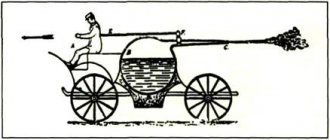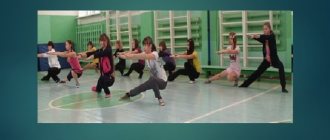Methodological commentary on Kuban studies lessons in 1st grade (p. 1)
Methodical commentary on Kuban studies lessons in 1st grade
The program of the course “Cuban Studies” in grade 1 is propaedeutic for studying the program of grades 2-4. It includes both local history material and material aimed at developing one’s horizons in general.
The topics of the first year of study consist of 4 sections. The sequence of studying the sections is not accidental: the study begins with what is already familiar to the child - family, favorite activities of relatives, learning one’s name - this is what allows not only to smoothly introduce the child into the world of “Cuban Studies”, but also ensures the process of soft adaptation of the first grader At school. The second section is devoted to the introduction of the child into school life, when the children become acquainted with the traditions of the school, with the peculiarities of behavior in it, with the main forms of cooperation with peers and adults. The topic of the third section is aimed at studying the native city (village, village, etc.). When organizing classes within the framework of studying this section, it is important to plan as many excursions, hikes, trips, meetings with interesting people as possible in order to form in children a broad idea of their small homeland, based on their own experience. The fourth section is devoted to the development of an attentive and caring attitude towards the environment. This sequence of studying sections makes it possible to implement the leading principle of organizing education in primary grades - from the particular to the general.
PROGRAM
I
grade (33 hours)
ME AND MY FAMILY
(8 ocloc'k)
A child’s closest world is family. Family composition. Last names, first names, patronymics of family members. The history of your name. Responsibilities of the child in the family, caring for other family members. Family traditions, customs, holidays, relics.
OUR SCHOOL
(8 ocloc'k)
Getting to know the school. Name (number), address of the school. School premises and their purpose. Respect for the work of school employees. Traditions of the school, famous students and teachers of the school. Relationships between students at school. Rules of behavior at school and their necessity. Determining your behavior at school.
HOMETOWN (VILLAGE, STANITSKA, HUTOR)
(9 hours)
The locality in which the child lives, its name, the most important enterprises, cultural institutions, attractions. The predominant professions of people in their hometown (village, village, hamlet). The street where I live. History of the name. Rules of behavior on city streets, in transport, public places and cultural institutions.
LET'S LIVE IN HARMONY WITH NATURE
(8 ocloc'k)
The beauty of the nature of our native land. Diversity of flora. The importance of plants in human life. Indoor plants, variety of shapes, colors of indoor plants. Their significance in human life. Diversity of fauna. Domestic and wild animals, their differences. Meaning in human life. Human relationship to plants and animals. Determining your attitude towards plants and animals.
Methodical comment
to the textbook - notebook "Cuban Studies" for 1st grade
The content of the textbook - notebook corresponds to the basic minimum content of general education for the course "Cuban Studies", the program of the course "Cuban Studies". This tutorial is intended for individual work.
The main goal of the first year of teaching this subject is to develop an attentive attitude to what directly surrounds the child: his family, relatives, close people, classmates, home street, animals and plants that are encountered every day - all that is part of the concept of Homeland. It is important to interest children in studying the subject “Cuban Studies” through the development of the child’s emotional perception, to teach him to see the unusual and be surprised in an environment that has already become ordinary for him.
In each of the four themes, several lines can be meaningfully distinguished:
1. Educational: children directly receive knowledge and consolidate it by completing tasks. It is based on the principle of problem-based learning. There are quite a lot of tasks aimed at enhancing students’ research activities.
2. Educational: constant emphasis on caring for what surrounds you. Particular attention should be paid to the education of students in the process of team formation.
3. Development of mental processes: the manual includes a system of tasks aimed at developing thinking, attention, memory, perception, and imagination. There are quite a lot of tasks to develop students’ speech. Assignments labeled “Discuss with the teacher and classmates” require the teacher to organize a discussion during which everyone can speak. At the same time, it is important to teach children not only to express their own opinions, but also to be able to listen to others. Children's life experiences should be used as often as possible.
Along with the notebook, it is recommended to have an album for creative work or a file folder for each child, where he could put drawings, essays, as well as those materials that can be found during search activities. It is recommended to do all drawings in the notebook with colored pencils. It is advisable to systematically organize an exhibition of students’ creative works and its discussion.
Next, a short commentary is given on each topic being studied, on the basis of which the teacher, at his own discretion, can build a lesson based on the individual characteristics of the students in his class, the territorial location and capabilities of the educational institution.
Lesson 1
.
Introduction to the subject of Cuban studies.
This lesson is recommended to be carried out in the first week of children’s schooling, when children are introduced to all school subjects. You should discuss the name of the subject with the children, look through the textbook, look at the cover, illustrations, and make assumptions about what will be studied during the year. Special attention should be paid to the address of the governor of the Krasnodar region to first-graders. You can also discuss with your children what school supplies will be needed during Kuban studies lessons.
Studying this subject can be presented to children as a journey through their native land. As accompanying persons, you can take with you a Cossack man and a Cossack woman, depicted under the symbols next to the schematic map of the Krasnodar Territory. This is not a mandatory component of the lessons, but if you introduce them as cross-cutting heroes, then they should not be idle guests in the lessons, but the initiators of games, problem situations, etc.
Particular attention should be paid to studying the diagram map shown on pages 2 - 3. It is geographically accurate and graphically includes the content of all four topics, so you can return to it while studying a particular topic throughout the year.
Lessons 2 – 3.
Let's get to know each other!
The story of my name. In these lessons, it is advisable to use psychological and role-playing games. For example, games will help you quickly remember the names of your classmates and unite your team:
- “Names.” Children stand in a circle. The first child says his name, the second says the name of the first and his, the third says the name of the first, the second and his, etc. You can play this game first in rows, or by dividing into groups - boys and girls, where fewer children are involved . This game can be played as a competition to see whose row will be the most attentive.
- "Alphabet". We need to determine which letters the names in the class begin with. In accordance with this, children are divided into groups and given various tasks: to depict objects starting with “their” letter (all other children guess the hidden objects); identify names that have the largest (or smallest) number of letters.
- “I know five names of boys (girls).” This game can be offered during physical exercises, jumping or walking, and for each jump (step) a name can be called.
- “There is no such name.” The game is played in the form of a competition in rows. Children take turns calling names. You cannot name the children sitting in this row. The row where the children never made a mistake wins.
- “Web.” Materials needed: a ball of thread. Instructions: “Sit in one large circle. If a ball falls into your hands, then you have the opportunity to tell us your name and tell us something about yourself. Maybe one of you would like to talk about his favorite toy, what he does best, or what he likes to do in his free time. You have a minute to think about what you want to tell us about yourself. If you don’t want to say anything about yourself other than your name, then you can simply take the thread in your hand and throw the ball to someone who doesn’t yet have the thread in their hand.” The teacher himself can start the game. In this way, the ball is passed from student to student until all the children are part of one gradually growing web. After this, you will need to dissolve the web. To do this, each child must return the ball to the previous one, calling him by name and, perhaps, retelling his story about himself. This continues until the ball returns back to the teacher.
Get full text
Work in a notebook (page 4). Children write a short text about themselves. The work can be carried out both orally and in writing (provided that students can write at least in block letters). It is advisable to invite the children to talk about how they are affectionately called at home, to discuss how they would like their name to sound in class. You can count how many children have the same names and agree on how to distinguish them when addressing them. You need to draw your self-portrait in the frame, and then comment on the drawing: for example, what is your mood in the drawing, what are you doing, what are you thinking about. This gives not only the child the opportunity to express himself, but also the teacher to diagnose the psychological state of the child in order to subsequently correct it and find an individual approach to each person. It is best to interpret this test together with a psychologist. This interpretation was proposed by R. Burns (USA, Institute of Human Development, Seattle):
Head.
The design of a large head usually suggests great intellectual pretensions, or dissatisfaction with one's intellect. A small head design usually reflects a feeling of intellectual or social inadequacy.
Eyes.
Large eyes in the picture suggest suspicion, as well as a manifestation of concern and hypersensitivity towards public opinion. Small or closed eyes usually suggest self-absorption.
| Due to its large volume, this material is placed on several pages: 1 |





